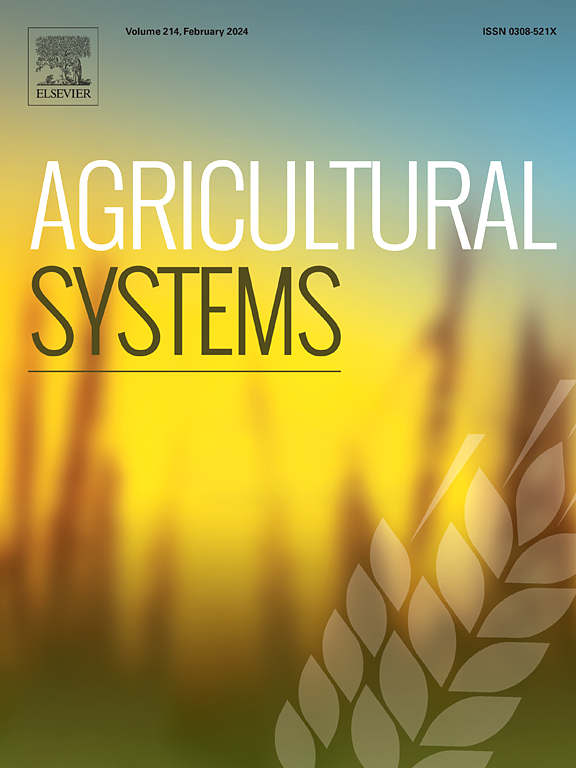到2050年共享社会经济路径和城市扩张共同影响下的农业用地未来
IF 6.1
1区 农林科学
Q1 AGRICULTURE, MULTIDISCIPLINARY
引用次数: 0
摘要
由于不断增长的需求、前所未有的人口增长以及气候变化和城市化等挑战,粮食安全面临越来越大的风险。因此,模拟气候变化和土地非农化对农业用地的综合影响具有重要的战略意义。本文章由计算机程序翻译,如有差异,请以英文原文为准。

The future of agricultural lands under the combined influence of shared socioeconomic pathways and urban expansion by 2050
CONTEXT
Food security is increasingly at risk due to rising demand, unprecedented population growth, and challenges such as climate change and urbanization. Consequently, modeling the combined effects of climate change and land conversion on agricultural lands is of strategic importance.
OBJECTIVE
This study simulates the combined effects of climate change and urban expansion on agricultural lands in western Iran, a region recognized as the food basket of the country.
METHODS
Land use maps for the past 30 years (1990–2020) were generated using Google Earth Engine and a scene-based approach. Urban expansion was simulated using the combination of multilayer perceptron, Markov chain and cellular automata. Data between 2000 and 2010 were used for calibration and data between 2010 and 2020 were used for validation. Subsequently, urban expansion by the year 2050 was simulated. To explore the influence of climate change, three climate models from the general circulation models were evaluated using mean absolute error, mean bias error, and root mean square error. The effects of precipitation deficiency on rainfed farming were investigated through three shared socioeconomic pathways (SSPs): SSP1–2.6, SSP2–4.5, and SSP3–7.0.
RESULTS AND CONCLUSIONS
Land use maps were generated with overall accuracies ranging from 93 % to 96 %, while the urban expansion model demonstrated an accuracy of 85 %, as determined by the area under the curve. Simulated maps showed figure of merit and producer accuracy values of 63 % and 67 %, respectively. Urban areas expanded by 110 % between 1990 and 2020, with a projected 78 % increase between 2020 and 2050, resulting in the loss of 71 km2 of agricultural land. Rainfed farming losses are projected to be insignificant by 2030 and 2040. However, by 2050, losses are estimated to range from 168 to 790 km2 in the SSP1–2.6 scenario, 260 to 865 km2 in SSP2–4.5, and 135 to 733 km2 in SSP3–7.0, depending on precipitation thresholds of 250 mm and 300 mm.
SIGNIFICANCE
The study shows that while climate change can damage agricultural lands on a broad scale, urban expansion threatens high-quality irrigated and garden lands, posing serious risks to food security and sustainability. These insights are valuable for governments and decision-makers assessing the future risks posed by climate change and land conversion to agricultural lands.
求助全文
通过发布文献求助,成功后即可免费获取论文全文。
去求助
来源期刊

Agricultural Systems
农林科学-农业综合
CiteScore
13.30
自引率
7.60%
发文量
174
审稿时长
30 days
期刊介绍:
Agricultural Systems is an international journal that deals with interactions - among the components of agricultural systems, among hierarchical levels of agricultural systems, between agricultural and other land use systems, and between agricultural systems and their natural, social and economic environments.
The scope includes the development and application of systems analysis methodologies in the following areas:
Systems approaches in the sustainable intensification of agriculture; pathways for sustainable intensification; crop-livestock integration; farm-level resource allocation; quantification of benefits and trade-offs at farm to landscape levels; integrative, participatory and dynamic modelling approaches for qualitative and quantitative assessments of agricultural systems and decision making;
The interactions between agricultural and non-agricultural landscapes; the multiple services of agricultural systems; food security and the environment;
Global change and adaptation science; transformational adaptations as driven by changes in climate, policy, values and attitudes influencing the design of farming systems;
Development and application of farming systems design tools and methods for impact, scenario and case study analysis; managing the complexities of dynamic agricultural systems; innovation systems and multi stakeholder arrangements that support or promote change and (or) inform policy decisions.
 求助内容:
求助内容: 应助结果提醒方式:
应助结果提醒方式:


